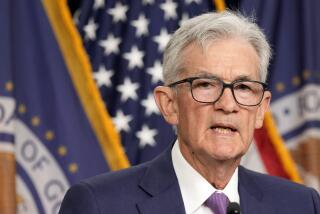Fed Unveils Proposed Change in Its Lending
- Share via
The Federal Reserve on Friday unveiled a major shift in the way it lends money to the nation’s banks, proposing to charge them more for the privilege but making it easier to get loans.
Private economists predicted the change would have no effect on consumer or business borrowing rates but should help smooth out volatility in the massive $60-billion daily market for short-term lending between banks. Fed officials also said the move did not involve a change in the central bank’s monetary policy.
Banks that currently go to the Fed’s so-called discount window are able to get loans that are about half a percentage point below the Fed’s target for the federal funds rate--the interest commercial banks charge one another for loans and the rate the central bank tinkers with in an effort to influence the health of the national economy.
Under the proposal, the Fed would remove that break and instead charge banks using the discount window at a rate one full percentage point above the federal funds rate.
The Fed has set the funds rate at a 40-year low of 1.75%, while the Fed’s discount rate is set at 1.25%. Under this proposal, the discount rate would be set initially at 2.75%.
Analysts said the switch may not make much difference on the rates banks charge on consumer and business loans because discount-window borrowing amounts to only about $100 million daily, a tiny fraction of the $55 billion to $60 billion in loans extended among banks in the federal funds market.
Fed officials said the higher discount rate would bring Fed operations more in line with how other nations’ central banks handle direct bank lending.
Private economists generally applauded the move as a good way to streamline lending processes.
A spokesman for the American Bankers Assn. said the group needed more time to study the proposal before commenting in detail.
Throughout the Fed’s history, the discount window has helped the Fed act as a lender of last resort to troubled banks.
But Fed officials emphasized that in normal times such loans make up only a small part of discount window borrowing, with the vast bulk of the loans going to banks that face a one-day cash crunch for unexpected reasons. The Fed currently has no loans to banks that can’t obtain financing through regular channels.
The Fed switch would mark the biggest change in Fed borrowing operations in about two decades. The Fed proposal could be revised before the central bank decides whether to implement the proposed changes after a 90-day comment period.
More to Read
Inside the business of entertainment
The Wide Shot brings you news, analysis and insights on everything from streaming wars to production — and what it all means for the future.
You may occasionally receive promotional content from the Los Angeles Times.










